Walking The Lines
by Bob Harding
Reprinted from "Crown Jewels of the Wire", April 1989, page 12
THE MYSTERIOUS M & C
The Marietta and Cincinnati railroad was one of the very early railroads
in Ohio. This line was started in 1841 and wound from Cincinnati on the Ohio
River east to Marietta which is also on the banks of the Ohio. Much of this area
was wilderness at that time. The line was the major route for transporting coal
and iron from the mineral rich southern Ohio counties. The coming of the
railroad caused a great deal of anticipation in this poor area. An early
historical account tells of the enthusiastic iron furnace workers stacking their
"pigs" close to where the bed was to be laid. The railroad was later
built from Cincinnati to Loveland, Blanchester, Chillicothe, McArthur, Athens
and finally to Marietta in 1857. Later the M & C railroad joined the B &
O at Parkersburg, West Virginia and was taken over by the B & O and a bridge
was built spanning the Ohio River.
There are a couple of early listings showing
the existence of telegraph on the M & C. An Athens, Ohio, directory listed a
telegrapher in 1865. I had the rare opportunity to search the depot in Athens
during its recent renovation. The attic showed no signs of insulators or pins. I
doubt that this was the original depot. Milholland's Bicentennial Edition lists
a seven mile McArthur and Zaleski telegraph line in 1878. McArthur and Zaleski
are both located on the old M & C and are approximately seven miles apart. I
have searched this section on many occasions with no luck, even with the use of
a metal detector.
Another section of the line that I have searched from time to
time is a place I'll call the "Amazon." This is probably the most
remote place in Ohio that I know. The name came from one of my buddy's
girlfriends who coined the phrase during a heated argument over his Toyota truck
that he lost in a quagmire in this area. Unfortunately she came along to help us
pull it out. She was irate, to say the least. She must have thought that we
enjoyed the 26 mile walk to the nearest town!
The "Amazon" showed evidence of an early
telegraph line. On the opposite side of the tracks from the newest poles, I
scaled a hill that had a tunnel cut through it. With the metal detector, I was
able to locate 3 pole locations. I did not find the pole bases or holes, but I
did find an old tool (possibly a lineman's hatchet), 3 very rusty tie wires,
some square wrought iron side bracket spikes and a large rusty lag bolt. I
returned to this area several times and raked the hillside like a madman. Not so
much as a fragment was found. Where the insulators are is still a mystery. These
tie wires were definitely from a very old line. My guess is the very newest
insulators on this side would have been CD 126's and 127's and most were
probably a threadless of some variety since the newer poles on the other side of
the track date back to around 1900.
The "Amazon" is not a hospitable
area and is really very lonely. My first trip to the "Amazon" will be
one I'll never forget. Rob Lloyd came down from Windsor, Ontario, for a week of
insulator hunting. We left for the M & C late on Friday night and tried to
sleep in the car at the Hope furnace until daybreak. At dawn we were in one of
those beautiful Ohio raging thunderstorms that only happen when you are miles
from shelter. We followed the line in the safety of our car until the rain
stopped. Finally we picked that area that passes through the Zaleski National
Forest to explore.
Our first stop was at a place called Moonville. The town no
longer exists and the only thing left is the name "Moonville" sculpted
in bricks on the old railroad tunnel. There is a legend about a ghost at
Moonville. A drunken brakeman was hit by a train late one night at the tunnel in
1880. Locals say that sometimes on dark nights you can see a lantern glimmering
and waving erratically near the tunnel. I never really had a notion to go down
there at night to check it out.
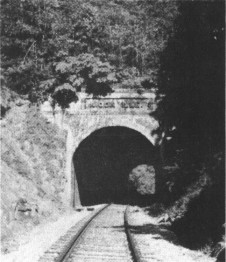
The Moonville Tunnel -- residence
of the Moonville "ghost"
We walked the tracks from Moonville to the town of lngham Station. The
original wagon road from Marietta to Chillicothe passed through this town. Now
all that is left are a couple of old foundations and an old cellar hole.
About
another half mile or so down the tracks is the ghost town of King Station. King
Station is the only ghost town I know of in Ohio with standing buildings. King
Station was a mining town built near the King Mine in 1864. On my first trip
here I found a couple of clay pipes and some old marbles between the siding boards
of the old general store. On this particular trip we found an old
telegraph pole (threaded) with a two pin crossarm, and almost half of a CD 731
no name, aqua insulator under an old house. I was glad Rob was along. He was
braver than I and crawled under the sagging rotting floor to get them. Rob also
was the one who got to carry the pole back.
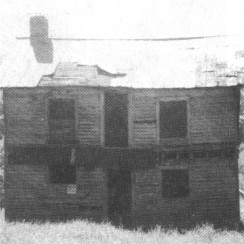
King Station ghost town house where telegraph pole and broken 731 threadless
were found. |
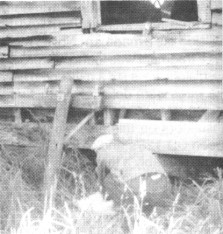
Rob Lloyd rescues a broken 731 from under the old house at King Station. |
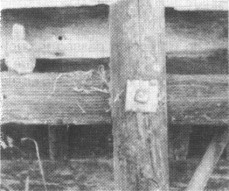
Old pole and 731 shard as they were pulled from under the house. |
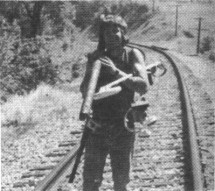
Bob Harding struggles with railroad mile
marker and gear the three miles back
to his car. |
We found a cool cast iron railroad mile marker. It was old and rusty and weighed about 60 pounds. It felt like
it weighed 260 pounds by the time I got it back to the car three miles away. I
carried this monstrosity along with the metal detector, camp shovel, camera and
canteen. Jack Snyder acquired the sign from me at the London, Ohio, show last
fall. Now, HE has to figure out what to do with it!
After cramming all the "finds" into the Shelby, we headed for the
"Amazon." Since this was my first time there I didn't know that I shouldn't
go across the railroad on the old dirt road. On the other side of the tracks is
a very steep grade that I call the "Whammys" because of the huge
washboard like ruts that run all the way down the hill. By the time I saw them
there was no turning back. At the bottom where the road finally smoothed out I
got out to check the damage to the Shelby. Luckily there was no damage but there
was also no turning back. The whole road was littered with pieces of black glass
slag. About another mile down, the road ended in a creek. The creek went through
a large culvert under the M & C. The only way out was through the creek
under the culvert where the road came out on the other side. Somehow we made it!
On the other side were the immense mins of the Richland Furnace built in the
early 1800's for iron smelting. We found a small dump in the ditch beside the
road. Rob found a green depression glass bowl in the dump. There was a lot of
slag glass from the old furnace in the ditch. One piece was really wild, swirled
with milky cobalt colored streaks. Soon the road widened and we decided to get
back to the house to unload all the junk we picked up. Unfortunately we didn't
find any whole threadless, but we did have a great time.
I've been back to the M
& C several times since then, but still no luck. Those threadless are out
there somewhere and I'll return again and again until I find them. It's one of
the few places left in Ohio where you can get away from the rat race and crowds
and feel a sense of history from the early 1800's.
| 